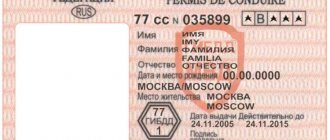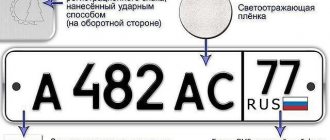Driving too long without breaks
If the road ahead is long, more than 1000 kilometers, then it would be advisable to divide it into small sections.
The most optimal distance that can be covered without rest is approximately 200-300 kilometers.
Stops should be short - no more than 10 minutes. The break time can be used to refuel, quench your thirst, eat, etc.
Don't try to do everything in one stop. Taking short but frequent breaks will help you stay alert on the road.
Sleeping while driving
When traveling behind the wheel, it is important to take breaks to sleep, since accidents caused by a driver who falls asleep are a fairly common problem. You need to go to bed at 21-22:00. If you go to bed later, the body will not be able to fully recover.
An important danger signal should be a gradual reduction in speed. If the driver has reduced the speed by 10-15% and practically stopped driving (he comes to his senses already near the side of the road or the middle of the road), it’s time to take a break.
A good remedy against drowsiness is an interesting interlocutor who constantly talks with the driver and does not allow him to switch off. It would also be a good idea to constantly chew nuts, seeds, and so on. This action will force the brain to work.
How to drive safely on the highway
One of the urgent tasks is driving along the highway. Truck drivers are in great demand today in the labor market, so many drivers have retrained for this profession. At first glance, everything seems simple. What could be difficult about driving on a straight road? But there are certain nuances and rules that those who work on trucks in the cargo transportation industry need to know about.
Take breaks
For example, you need to drive 800 km. There is no need to set a goal to pass them all at once. It's better to break it down into stages. After driving 150 km, it is advisable to stop and get out of the car so that your back straightens and blood circulation normalizes. You can walk around and stretch, but you shouldn’t stay and sit in the car. After warming up, you can continue on your way.
Comfort in the cabin is important for the driver’s well-being; the IVECO commercial vehicle catalog will help you choose models equipped with ergonomic seats, multimedia, and climate control.
Speed on the highway
If the driver has recently received a license and has little experience, then he must drive at a speed of no more than 70 km/h according to the rules. But on the highway, everyone tries to push the maximum and drive at 100 km/h, or even more.
If you need to turn off the road, pay attention to the speedometer! It seems to you that you have slowed down to 20 km, but it shows 40-50 km. This is due to the fact that the eyes get used to high speed and sensations become deceptive. If you do not control the movement using instruments, then the turn can become fatal.
Braking on the highway
In driving school they teach you to brake by pressing the clutch to the floor. But when the car is traveling at high speed, you should not brake like that. You must first slow down to 30-40 km/h. Then depress the clutch. The car will not stall. There is nothing to be afraid of.
Overtaking on the highway
If you have two lanes in one direction, and you want to overtake some truck that is driving in the second lane. You need to look in the rearview mirror to see if another car has started overtaking behind you. This also applies if you are driving on a single-lane highway.
If the lane is one way and the other, then first you need to let the oncoming car and the car that started overtaking before you pass (you need to look in the mirror).
Trucks often help drivers, both experienced and new. If the truck sees a car from behind that is peeking behind it, it is indicated either to turn left or to turn right - it can be overtaken or not.
Rules for overtaking on the highway
Do not press the pedal too hard when overtaking. Beginners press the gas so that the pedal reaches the floor. In this case, the car begins to accelerate slowly, as a large amount of fuel is overflowing. If the pedal is pressed too hard, you should release it and press it again. Or change to a lower gear before overtaking.
If you cannot see what is behind the rise after the hill, then you should not drive into oncoming traffic. Overtaking in the city in the oncoming lane is also not recommended. They only overtake in their own lane. It is worth considering when entering the oncoming lane that the car that is driving towards yours is also moving at considerable speed.
If there are two lanes in the same direction on the highway, then you should not always drive to the far left. We must occupy the far right. The leftmost lane is intended for driving around, ahead of a car or some obstacle, for example, a bad road: holes, bumps.
But it's worth keeping an eye on your rearview mirror, when a car is approaching at high speed, they usually flash their headlights. So that the driver understands that you will yield to him, move over, and show the person behind you to turn right.
If the steering wheel becomes weightless, what should I do?
You are driving along the highway and suddenly feel that the steering wheel has become “soft” and weightless. This happens when the wheels lose traction with the asphalt. You immediately need to let off the gas for a couple of seconds, the car passes, the steering wheel returns to normal. The fight with the asphalt becomes familiar. You can continue on your way.
A serviceable car is a guarantee of safety. You can find any original Iveco components and spare parts at the Commercial Vehicle Auto Center.
Safe roads to you!
Read with this article:
Conventional signals of drivers - on the road we understand each other without words
How to sell a car profitably
Auto expert Dmitry Vladislavovich Klyuev advises how to protect your pet on the road.
Windshield care
Failure to maintain a safe distance
The most common mistake drivers make on a high-speed highway is failure to maintain distance.
To avoid accidents, it is necessary to maintain the most comfortable distance between cars. Then, if the car in front suddenly brakes or changes lanes, the car behind will be able to do the same and avoid a collision.
Distance and speed limit
The first thing that needs to be observed on the highway is the speed limit. It's probably no secret that in a head-on collision the speeds add up. For example, if a car was traveling at 90 km/h and collided with another similar car, the total impact speed would be 180 km/h.
Try not to go beyond the traffic rules, even if you have a powerful and “safe” car. Even the most expensive foreign cars cannot survive at high speed.
Also, do not forget about the optimal distance. On the highway it must be increased several times, since the car in front can brake sharply, which will cause an accident. If weather conditions are bad, you should further increase the distance and reduce the speed.
Lack of car tools and spare wheel
Breakdowns on the road are a common occurrence. The car can break down at any time, so it is very important to always have the necessary tools and a spare tire with you.
Before traveling, it is important to carefully double-check all tools to ensure they are in good condition. We must not forget about the condition of the spare tire, as it may be deflated.
If you check everything in advance, you can avoid life-threatening situations and you won’t have to interrupt your journey somewhere in the middle.
We are on Twitter:
Login Registration
Automotive news
Rules for the movement of heavy trucks in the automatic weight control zone have been adopted. The Federal Tax Service has approved the application form for the death or destruction of a vehicle. In Russia, it is forbidden to disembark children without a ticket from buses. A new sign 6.22 has been introduced in the traffic rules - “photo and video recording” Testing for alcohol dependence has been postponed for another year. The Ministry of Health has updated the requirements for completing car first-aid kits, the Ministry of Transport has approved the procedure and terms for storing diagnostic maintenance cards. Obtaining permission for international transport will now be done in a new way. You can now check your MTPL policy for authenticity online. The Central Bank has set new tariffs for MTPL.
/ Legal articles on the topic of automobile law / Traffic and safety issues / First time on the highway? Tips and tricks
First time on the track? Tips and tricks
Drivers are not born, drivers are made. Believe me, almost all motorists, including dashing minibus drivers who are able to simultaneously steer, shift, drink coffee, talk on the phone and count out change in dense city traffic, were once beginners whose hands trembled and their backs were sweating during their first independent trips.
So, you are a newbie who has recently received your driving license and is slowly racking up kilometers along the well-known streets of your city. After weeks or months (it’s different for everyone), you already have a more or less tolerable skill in driving in urban conditions and begin to notice with satisfaction that the driving process ceases to be a constant stress for you.
After some time, you begin to enjoy driving.
However, sooner or later in the life of almost any novice driver, another stage comes that can damage a lot of nerve cells.
We are talking about the need for the first trip to a country road. Believe me, this is a very important moment, since the experience of a beginner driving on the highway can have a great influence on his further development as a driver.
How to go on the track for the first time as a beginner? In this article we will try to formulate some useful recommendations for those who are going to drive on the highway for the first time in their lives.
In general, beginners should not drive onto country highways unless absolutely necessary for the first time after obtaining a license. But there are situations when circumstances force a beginner to get behind the wheel and go conquer his first kilometers of federal highways.
When going out on the highway, first of all, get rid of the illusion that you are already an experienced driver. The fact that you stopped stalling when starting from a stop and learned to start uphill almost without rolling back does not mean anything at all. You must be clearly aware that you are an inexperienced beginner on the track.
From the point of view of the driving process itself, driving on the highway, in itself, is no more difficult than in the city. And even vice versa, to some extent it is simpler (less maneuvers, less movements, everyone goes in the same direction). But at the same time, it is much more dangerous, since the cost of a mistake is incredibly high. After all, if an accident in the city is, as a rule, just the repair of broken iron, then on the highway everything often ends much worse. The vast majority of accidents involving death or serious injury occur on highways where cars are traveling at very high speeds.
In principle, there are few recommendations on how to drive on the highway for a beginner. And I would even say that there is only one: the main rule for a beginner on the track is not to take risks! Nothing and never!
Are you afraid to overtake a truck that is traveling 70 km/h because you see it as a risk? Don't overtake. Follow her for 2, 3, 5, or at least 20 kilometers and overtake her only in the place where you have one hundred percent confidence in the safety of the maneuver. As time passes, you will learn to more objectively assess the degree of risk on the highways and overtaking a truck will no longer be an event for you. But while you still don’t know how to do this, don’t take unnecessary risks. Remember - they are waiting for you at home safe and sound.
Are you afraid to drive more than 100 km/h because you have not yet learned how to fully control the car at such speeds and feel discomfort? Drive slower. 80-90 km/h for the highway is a completely normal speed at which most trucks move.
However, it is also not recommended to drive very slowly on the highway, since there is a high risk that some racer at 160 km/h could fly behind him, who could not have foreseen that the car in front of him was moving at a snail’s pace.
On highways with traffic in several lanes, try not to get into the far left lane unless absolutely necessary - drive in the right lane.
Be sure to indicate all your maneuvers on the highway with turn signals in advance. In principle, this should be done at all times and everywhere, but on the highway this rule is especially relevant, since here it is customary to drive at high speeds and there may not be enough time to navigate a given situation.
Before overtaking, changing lanes, or turning, be sure to look in your mirrors - it often happens that someone behind you has already started overtaking before you.
Always keep a distance from cars in front and read the traffic situation in advance. Don't count on your brakes, no matter how good they are. If you notice that the traffic ahead has slowed down, you don’t need to approach it headlong and then brake recklessly - this is a very bad habit that is inherent in thoughtless and adventurous drivers. It is much easier and safer to release the gas pedal in advance.
When driving out on the highway, remember: your safety is in your own hands!
The car is a source of increased danger
What documents are needed to register a car?
new to the track
24697
No comments yet. Yours will be the first!
Write a comment
New comments
Badyrgy → Removal and expungement of a criminal record under Art. 264.1 of the Criminal Code of the Russian Federation 21 hours ago
Convicted in 2014 of Part 1 of Article 264 of the Criminal Code of the Russian Federation with restriction of freedom and deprivation of rights for 1 year. How to expunge a criminal record? And where to go
Vladimir → Is it necessary to give way to a bus leaving the bus stop… 15 days ago
The rules state that the driver must give way to a bus departing from a stop within the city limits, but I drive at a speed of 60 km per hour at the main speed...
Automotive Lawyer → Deprivation of the right to drive under Art. 264 of the Criminal Code of the Russian Federation. About the most... 1 month ago
Hello. The period of criminal punishment in the form of deprivation of the right to drive runs, regardless of whether the vehicle is passed or not. The traffic police have been punished for enforcing this...
Evgeniy → Deprivation of the right to drive under Art. 264 of the Criminal Code of the Russian Federation. About the most... 1 month ago
Good evening! In 2014, he was convicted under Part 264 of the Criminal Code and served a real sentence of 2 years in a penal colony; the court also deprived him of his license for 3 years, after...
Automotive Lawyer → Deprivation of the right to drive under Art. 264 of the Criminal Code of the Russian Federation. About the most... 1 month ago
Hello. The terms of deprivation under the article of the Code of Administrative Offenses of the Russian Federation and under the article of the Criminal Code of the Russian Federation are not cumulative. Each term is calculated independently, i.e., independently of each other
Driving in unfamiliar terrain without a map
It would seem that everyone already knows that you need to take a map and a navigator with you on a trip. However, many people still don’t do this and end up wandering around in circles for hours, hoping to find the right route. You shouldn’t hope that your brain will remember the route if you look at the route at home.
Some experienced drivers recommend writing down key points on a separate sheet in advance and using this plan. This way the driver can adjust the route without stopping.
Good voice guidance is important in a navigator, which will allow you not to be distracted from the road.
Overtaking on the highway
According to official statistics, the most common cause of accidents on the road is improper overtaking. Drivers are often in a hurry, do not notice oncoming cars or hope to pass. Moreover, more than 90% of all accidents on the highway end in death. The speeds are high, so only a few manage to survive.
When overtaking, you should adhere to the following rule: wait for the safest possible moment. It is better to wait a few minutes, but make sure that there are no obstacles on the roadway.
If you are not sure that your car can handle overtaking, it is better not to risk it. The ideal moment for overtaking is when there are no cars on the oncoming lane or they are far on the horizon.
Important! Remember that you are not only risking your own life, but also putting at risk other vehicles where small children may be present. A few minutes of waiting will not change the situation, even if the driver is in a hurry.










